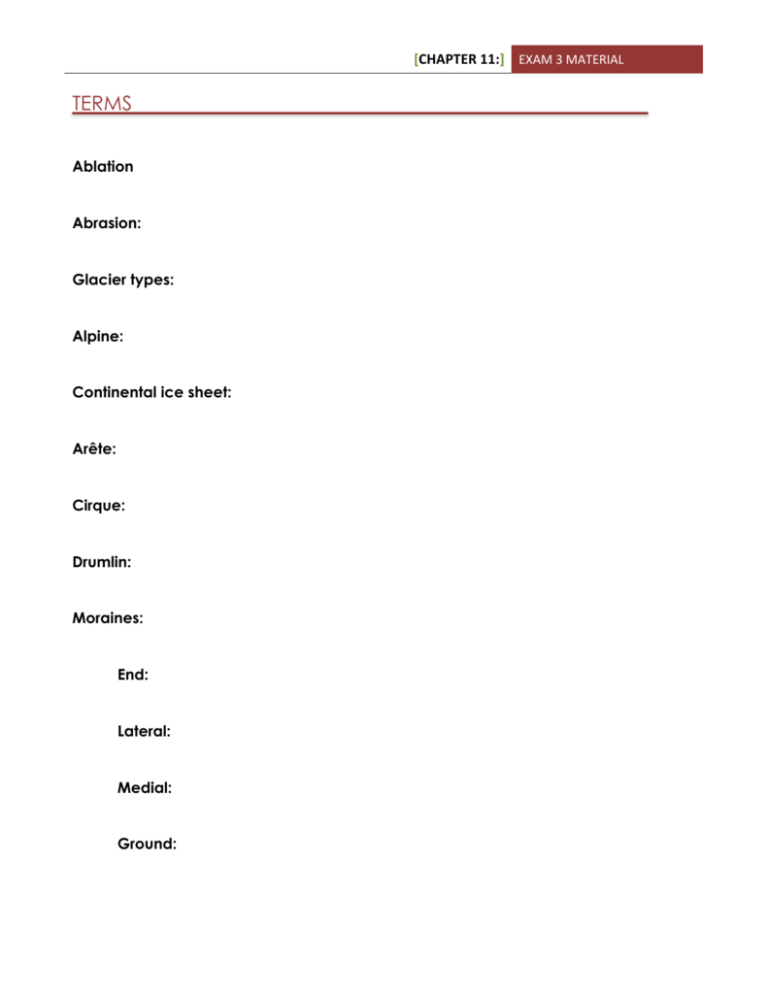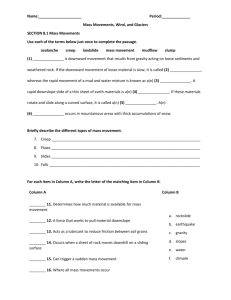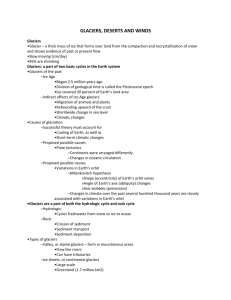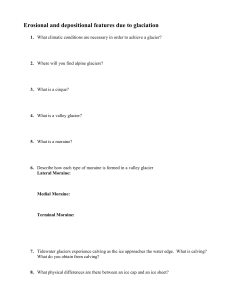Chapter 11:
advertisement

[CHAPTER 11:] EXAM 3 MATERIAL TERMS Ablation Abrasion: Glacier types: Alpine: Continental ice sheet: Arête: Cirque: Drumlin: Moraines: End: Lateral: Medial: Ground: [CHAPTER 11:] EXAM 3 MATERIAL Esker: Fiord: Striations: Hanging valley: Horn: Kame: Kettle: Outwash plain: Plucking: Roche moutonnee: Tarn: Till: Zone of accumulation: Zone of ablation: [CHAPTER 11:] EXAM 3 MATERIAL REVIEW QUESTIONS 1. Where are glaciers found today? What percentage of Earth’s land are do glaciers cover? a. The only present-day continental ice sheets are those covering Greenland and Antarctica. Glaciers cover 10% of Earth’s land today, although in recent geologic past, they were three times more extensive. 2. Describe how glaciers fit into the hydrologic cycle. What role do they play in the rock cycle? a. Water of the hydrosphere in constantly in a cycle, water is evaporated from the oceans into the atmosphere, precipitated upon the land, and carried by rivers and underground flow back to the sea. However sometimes when precipitation falls at high elevations or high latitudes, the water may not immediately make its way toward the sea; instead they may become part of a glacier. Water can be stored as glacial ice for up to thousands of years. They are part of the rock cycle because glaciers are among the processes that perform a very basic function in the rock cycle (that is all the book said lawl). 3. Each of the following statements refers to a particular type of glacier. Name the type of glacier. a. The term continental is often used to describe this type of glacier. i. Continental Ice Sheets b. This type of glacier is also called an alpine glacier i. Valley Glaciers c. This is a glacier formed when one or more valley glaciers spreads out at the base of a steep mountain front. i. Piedmont glaciers d. Greenland is the only example in the Northern Hemisphere. [CHAPTER 11:] EXAM 3 MATERIAL i. Ice Sheets e. This is a stream of ice leading from the margin of an ice sheet through the mountains to the sea. i. Outlet glaciers 4. Describe the two components of glacial flow. At what rates do glaciers move? In a valley glacier, does all of the ice move at the same rate? Explain. a. Two components of glacial flow include plastic flow, which involves movement within the ice, and basal slip, where the entire ice mass slips along the ground. The lowest portions of most glaciers are thought to move by this sliding process. b. Unlike streamflow, glacial movement is not as obvious, friction plays a role in making part of the ice move at different speeds than other parts. However, average velocities vary considerably from glacier to glacier. Some move so slowly that trees and other vegetation may become well established in the debris that has accumulated on the glacier’s surface, whereas others may move at rates of up to several meters per day. c. I kind of answered the last part in part A. Not all of the ice moves at the same rate because of friction (throw some pickles on a wall, they won’t all fall down the wall at the same rate, one will be the winner). 5. Why do crevasses form in the upper portion of a glacier but not below a depth of about 50 meters? a. The upper 50 meters or so of a glacier is not under sufficient pressure to exhibit plastic flow, rather the ice in this uppermost zone is brittle and is appropriately reffered to as the zone of fracture. The ice in this zone is carried along “piggyback” style by the ice below. When the glacier moves over irregular terrain, the zone of fracture is subjected to the tension, resulting in crevasses. These gaping cracks may extend to depths of 50 meters, but below this depth, plastic flow seals them off. 6. Under what circumstances will the front of a glacier advance? Retreat? Remain stationary? [CHAPTER 11:] EXAM 3 MATERIAL a. Glaciers advance when the accumulation of ice exceeds ablation, which is the loss of ice at the lower end. Glaciers will advance until the two factors balance. b. Glaciers retreat when a warming trend increases ablation and/or if a drop in snowfall decreases accumulation. Like advancement, this will happen until accumulation and ablation become balanced. c. Glaciers will remain stationary when the two are balanced. 7. How do glaciers accumulate their load of sediment? a. Through the process of plucking, which occurs when meltwater penetrates the cracks and joints of bedrock beneath a glacier and freezes. When water freezes it expands, exerting tremendous leverage that pries the rock loose. In this manner sediment of al sizes, ranging from particles as fine as flour to blocks as big as houses, become part of the glacier’s load. 8. How does a glaciated mountain valley differ in appearance from a mountain valley that was not glaciated? a. Glaciated mountain valleys create U-Shape glacial troughs that form during glaciation; these narrow valleys created by streams undergo a transformation as the glacier widens and deepens them, creating a Ushape. Without glaciation, valleys are usually narrow and V-shaped because streams are well above base level and are therefore downcutting. Also, glaciers straighten the valley. As ice flows around sharp curves, its great erosional force removes the spurs of land that enxtend into the valley. 9. List and describe the erosional features you might expect to see in an area where valley glaciers exist or have recently existed. a. Hanging valleys are common where valley glaciers existed, which are glaciers confined to a mountain valley, which in most instances had previously been a stream valley. Another erosional feature are pater noster lakes, which are depressions filled with water caused by plucking and scouring by abrasive force of the ice. A third feature is a cirque, which are at the heads of a glacial valley, it is a bowl-shaped depression which have precipitous walls on three sides but are open on the [CHAPTER 11:] EXAM 3 MATERIAL downvalley side. Another feature is a tarn, which is a small lake created after the glacier has melted away, the cirque basin is often occupied by this small lake. The final feature are fiords, which are deep, often spectacular, steep-sided inlets of the sea that are present at high latitudes where mountains are adjacent to the ocean. They are drowned glacial troughs that became submerged as the ice left the valley and the sea level rose following the Ice Age. 10. What is a glacial drift? What is the difference between till and stratified drift? What general effect do glacial deposits have on the landscape? a. Glacial drift is a term for sediments of glacial origin, no matter how, where, or in what form they were deposited. b. Till drift is deposited as glacial ice melts and drops its load of rock fragments. Characteristically unsorted mixtures of many particle sizes. Stratified drift is sorted according to the size and weight of the fragments. Sediments are not deposited directly by the glacier, but rather they reflect the sorting action of glacial meltwater. c. The landscape is made up of foreign debris that was thought to have drifted there by floating ice during an ancient flood. Whether till or stratified, glacial drift is responsible for the deposition of foreign material in the landscape. 11. List the four basic moraine types. What do all moraines have in common? What is the significance of terminal and recessional moraines? a. Lateral, Medial, End, and Ground morraines. b. All moraines are layers or ridges of till. c. The very first end moraine to form signifies the farthest advance of the glacier and is called the terminal end moraine. Those end moraines that form as the ice front occasionally stabilizes during retreat are termed recessional end moraines. 12. List and briefly describe four depositional features other than moraines. a. Kettles – Basin or depressions formed when blocks of stagnant ice become wholly or partly buried in drift and eventually melt, leaving pits in the glacial sediment. [CHAPTER 11:] EXAM 3 MATERIAL b. Drumlins – steamlined, asymmetrical hills composed of till, ranging in height from 15-60 meters and average .4-.8 kilometers in length. c. Eskers – Sinuous ridge composed largely of sand gravel deposited by a stream flowing in a tunnel beneath a glacier near its terminus. d. Kames – A steep-sided hill composed of sand and gravel originating when sediment collected in openings in stagnant glacial ice. 13. Examine the photo of the drumlin in Figure 11.23. From what direction (right or left) did the ice sheet advance in this area? a. The ice sheet advanced from left to right, then retreated from right to left. 14. How does a kettle form? a. Kettles form when blocks of stagnant ice become wholly or partly buried in drift and eventually melt, leaving pits in the glacial sediment. 15. About what percentage of Earth’s land surface was covered at some time by Pleistocene glaciers? How does this compare to the area presently covered by ice sheets and glaciers? (check your answer with Question 1.) a. Almost 30% was covered by Pleistocene glaciers at some time. This compares perfectly with the answer to question 1. It is now 10%, and it used to be 3 times as extensive, or close to 30%. Today the total volume of glacial ice is 25 million cubic km, whereas it used to be 70 million cubic km. 16. During the Pleistocene epoch the extent of glacial ice in the Northern Hemisphere was about twice as great as in the Southern Hemisphere. Briefly explain why this was the case. a. The primary reason the Northern Hemisphere was about twice as great as in the Southern Hemisphere is that the Southern Hemisphere has little land in the middle latitudes, and therefore the southern polar ice could not spread far beyond the margins of Antarctica. By contrast, North America and Eurasia provided great expanses of land for the spread of ice sheets. [CHAPTER 11:] EXAM 3 MATERIAL 17. Describe at least 4 effects of Ice Age glaciers aside from the formation of major erosional and depositional features. a. Crustal Subsidence and Rebound – In areas that were centers of ice accumulation, the land has been slowly rising over the past several thousand years. The land is rising because the added weight of the 3kilometer-thick mass of ice caused downwarping of Earth’s crust. b. Sea-Level Changes – Glaciers used to cover roughly 30% of Earth’s land surface and now covers only about 10%. As the glaciers melted, the water has been re-circulated back into the hydrosphere and has elevated the sea level. Estimates suggest that sea level was as much as 100 meters lower than today. c. Ice Dams Create Proglacial Lakes – Ice sheets and alpine glaciers act as damns to create lakes by trapping glacial meltwater and blocking the flow of rivers. Some of these lakes are relatively small, short-lived impoundments. Others can be large and exist for hundreds or thousands of years. d. Pluvial Lakes – In arid and semiarid areas on all of the continents, temperatures were lower and thus evaporation rates were lower, but at the same time moderate precipitation totals were experienced. This cooler, wetter climate formed many pluvial lakes (pluvis is latin for rain). 18. How might plate tectonics help us understand the cause of ice ages? Can plate tectonics explain the alternation between glacial and interglacial climates during the Pleistocene? a. Many scientists have suggested that ice ages have occurred only when Earth’s shifting crustal plates have carried the continents from tropical latitudes to more poleward positions. Because glaciers can form only on land, we know that landmasses must exist somewhere in the higher latitudes before an ice age can commence. b. Plate tectonics cannot be explain the alternation between glacial and interglacial climates during the Pleistocene epoch because climatic changes brought about by moving plates are extremely gradual. [CHAPTER 11:] EXAM 3 MATERIAL








